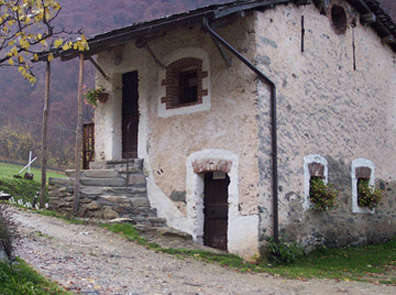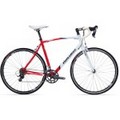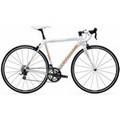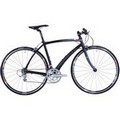
Bicycling in Italy is a passion among the Italian people. No where else in Europe compares with the diverse geography and the breath-taking scenery. Ancient houses, churches, and medieval buildings dot rolling hills. Ancient villages and towns sit atop hills and hide amongst wheat fields and farms in the valleys that spread out before you. Vineyards and olive groves cover the slopes. Friendly people stroll along narrow back roads, stopping to visit with neighbors or to cool off under a tree.

If you go touring in Italy, you can choose the Mediterranean climate of southern Italy or the cool days in the Alpine mountains. Some of the top areas for bicycle touring include the Tuscany and Umbria regions. Just a short distance northwest of Venice is the Veneto region, a bicyclist’s paradise among the varied terrain at the base of the pre-Dolomite mountains.
In the Veneto region, you will ride on excellent roads for cycling that have low traffic volumes and considerate motorist. Cherry orchards and olive groves fill the countryside. And ancient walled towns and castles can be seen among the hills.
When most people think about bicycling in Italy, the region of Tuscany comes to mind first. This region has great food and wine, authentic Italian lifestyle and culture, and art from all ages and styles. If you want to find an area that has less car traffic and more winding country roads, then the province of Siena may be your choice. Aanother close neighbor is the Umbria region, which is just as beautiful and charming as Tuscany.
A great web site for information about every region of Italy is Dolcevita. They discuss the culture, landscape, towns, cuisine, and about any else you may want to know about each region.
When to Go
Generally for touring in Italy, the best time to visit is in the spring and autumn months. During this time, the temperatures are pleasant, the crowds are few, and the scenery is wonderful. The summer months are hot, except in the northern regions where the temperature are mild. Italy during the entire month of August is quite crowded due to vacationing Italians and other Europeans. The late fall and winter months can be quite rainy and cold.
For the best cycling months, I recommend:
- Southern Italy: April and October
- Middle Italy: May and September
- Nothern Italy: June, July and September
- High mountain regions: July
How to Get There and Beyond
Italy’s rail network is extremely well connected to the rest of Europe: from Milan and Turin, Eurostar Italia travels through the Alps to Lyon, while TGV goes from and to Paris. Incredibly comfortable Cisalpino trains connect Italy with Switzerland. Elipsos takes you from Barcelona to Milan, Artesia links Paris to Rome, Milan, Florence, or Venice. And, you can also ride CityNightLine from various Northern European cities. You can rest in a comfortable cabin well equipped with private shower and toilets. Visit Rail Europe’s web site for routes, schedules, and costs.
For flying into Italy, the Rome airport may be your best choice. Rome is centrally located and has a rail link to the Termini station. Good to know if you land in Rome from North America, Fiumcino Airport is far from the city, but well-connected by the Leonardo da Vinci train.
The luggage space on most trains should be sufficient to handle a full size bike box or case. Many of the regional trains carry assembled bicycles either in bike racks or as luggage in the baggage area. The timetables for the Italian regional trains have symbols that show which trains allow assembled bicycles. Unfortunately, most of the high-speed, long-distance trains do not carry assembled bicycles. Consequently, the bicycle will have to be transported as baggage, which may require a box or case. This restriction will also apply to most of the international trains you may use to get into Italy.
You can travel to other major cities, such as Milan or Naples, or explore some of Italy’s charming towns, such as Pisa and Turin, or the scenic Lake Como. The good news is that visiting these cities by rail is a breeze thanks to a thoroughly improved rail network. Though the cities themselves may not be cheap, rail travel in Italy is relatively inexpensive, making it a good means of travel between towns.
Lodging and Food
During the summer tourist season, the hotels must be reserved months in advance. For the month of August, you probably need to seek reservations almost a year in advance. Fortunately, the prime bicycling in Italy months of spring and early fall should offer a large selection of rooms. In a lot of the towns, you may be able to get a room the day of your visit. Either call ahead or stop at the local tourist office when you first get in town to check on room availability. The offices are excellent for working with cyclists.
In recent years, ‘agritourism’ has become popular all over Italy. This type of tourism is orientated around having a rural experience which you share with the family who owns the farm or agritourism on which you are staying. Generally, these properties are vineyards or orchards and you are able to enjoy the fruits of the farm and in many cases your meals are prepared in traditional settings and dishes by the family itself. Many converted farmhouses in the Italian countryside will receive guest for one or multiple nights. Many will offer an evening meal with the room. Staying in an agritourism home provides you with a perfect situation to experience Italian farm life.
Try these sites for information and reservations for agritourism overnight stays:
And of course, you can check out the typical hostels that are located all over Italy: Hostel World.
Food and wine in Italy are a way of life. The food is fantastic, especially the homemade pasta and sauces. Each region has it own type and style of pasta dishes. In most eating establishments, they buy only fresh food, usually obtained at the local market that day. Just like all the local food, you need to try the local wines. The prices will be fair and the choices abundant. So in Italy, drink and eat to your heart’s content.
Your Bicycle
The type of bike that you will need for bicycling in Italy depends on your planned route. In general, the roads are well paved and without potholes. In rural Italy, you will find quite a few dirt and gravel roads. So it is best to check with your tour operator to make sure of your ride. In fact, most of the tour companies rent or supply bicycles with their tours. Common types of bicycles available include hydbrid, touring road, and mountain bicycles.
For general touring in the cities and among the countryside, a hydbrid or touring bicycle with wide tires (say around 28 to 36mm) will handle most roads. Mountain bikes will work for road touring (and trails too) if you switch out the very wide tires to something closer to 36 to 40mm wide. Some of the hills can be quite steep (6 to 12 percent grade) for a double crankset. If you’re going to bicycle in northern Italy, the mountain triple crankset would be a better choice. I would strongly recommend that you stick with a touring triple or mountain triple for the steep hills in the countryside.
Renting a bike can be challenging unless you are starting from a major city or plan on using a touring company bicycle. Some suggestions include:
- Randotrek: Provides fully equipped top quality bikes. In the Bracciano Lake District, they will deliver your bike directly to your accommodation with no extra charge.
- Bike Rentals Plus: Quality bikes (including tandems) and they delivery to your hotel, airport, or train station. They have over 100 locations in Italy and France.
- Top Bike Rental: Quality touring, hybrid, and mountain bikes in Rome.




We are a group of cycling lovers hailing from middle class families from the Mumbai metropolitan region, the financial hub of India, and have cycle toured across the country and in neighbouring countries like Sri Lanka.
For us, cycling is both the cleanest means of innocent wandering in lesser visited places and also the solution for all the woes like traffic and pollution that make life in urban areas miserable.
For a team which has come together through various expeditions in the last decade, a cycle tour in Europe is the natural way ahead. Apart from visiting places of importance, the cycle tour is an attempt at witnessing cycling culture of Europe and if possible, implement the learnings once we come back home.
The one month, three phased tour planned for September of 2013 has been designed keeping in mind the motivating thoughts.
After landing in Paris and cycling down the Avenue des Champs-Élysées, the culmination
point of theTour De France, we will cycle around 600 km till Amsterdam, crossing two international borders. In the Dutch city which has made a name for itself as an active cycling hub, there will be meetings with civic authorities and non-profits to get to know how they made it all possible.
An overnight train journey with the bikes in tow—a speciality of Europe—will take us to Berlin and from there we will cycle down one of the 13 Euro Velos or the web of dedicated ‘cycle highways’ and go southwards. The German countryside with its obsession for sustainability, Czech Republic and the beautiful Austria will be the highlights of this leg, before we end in Milan, having fulfilled the long-cherished desire of climbing the Alps Mountains.
From Milan, we fly back to India with a manifold increase in our conviction about cycling.
We would love to know from your experience, how we can go ahead about cycling in Italy. Where will get more chance to cycle as well as visit good places. Your assistance will help us to plan this route.
Awaiting for your response.
Thank you
Prashant Nanaware
nanawareprashant@gmail.com
Hi Prashant,
Sounds like a great tour!! Be sure to come back and share your experiences!